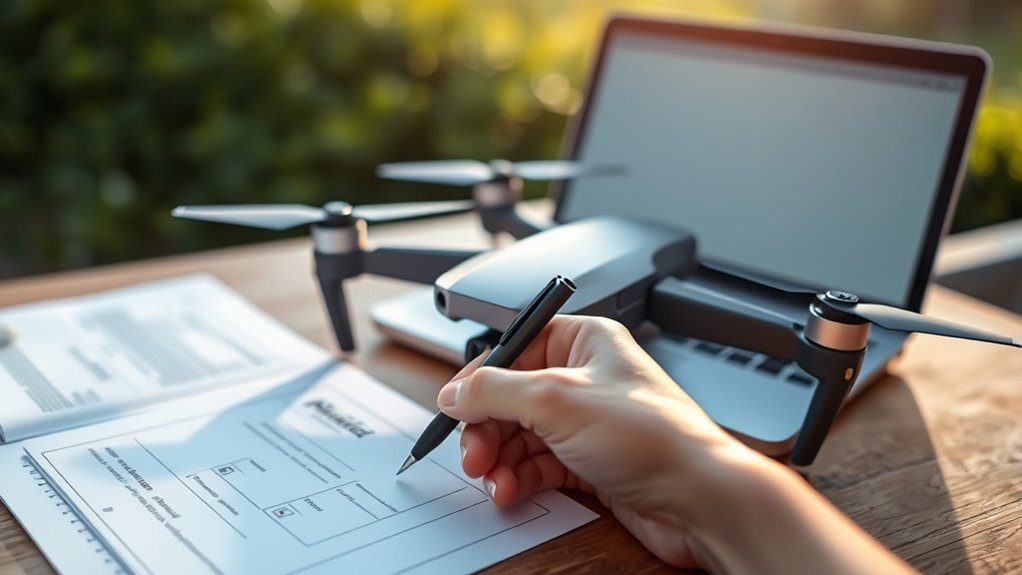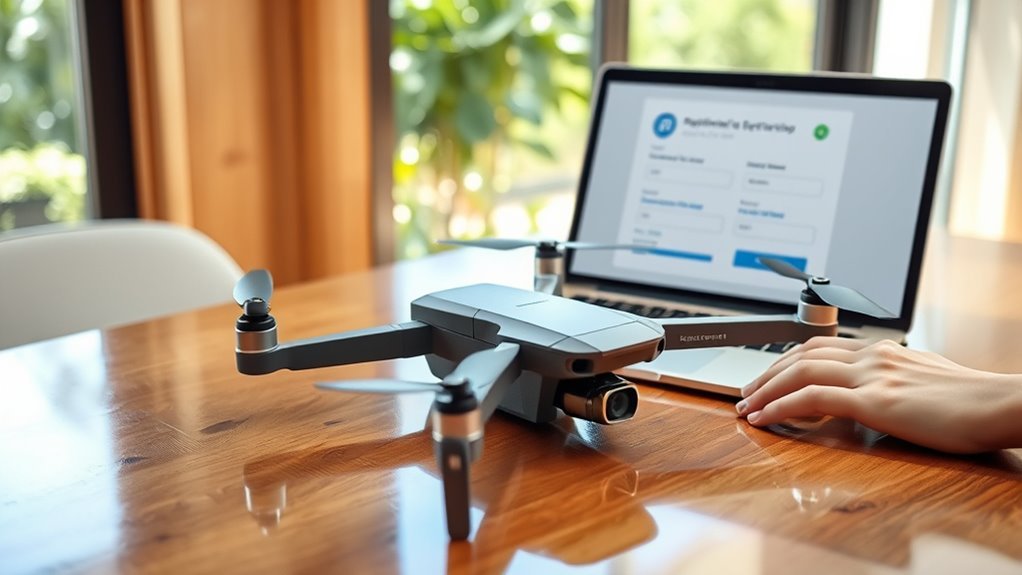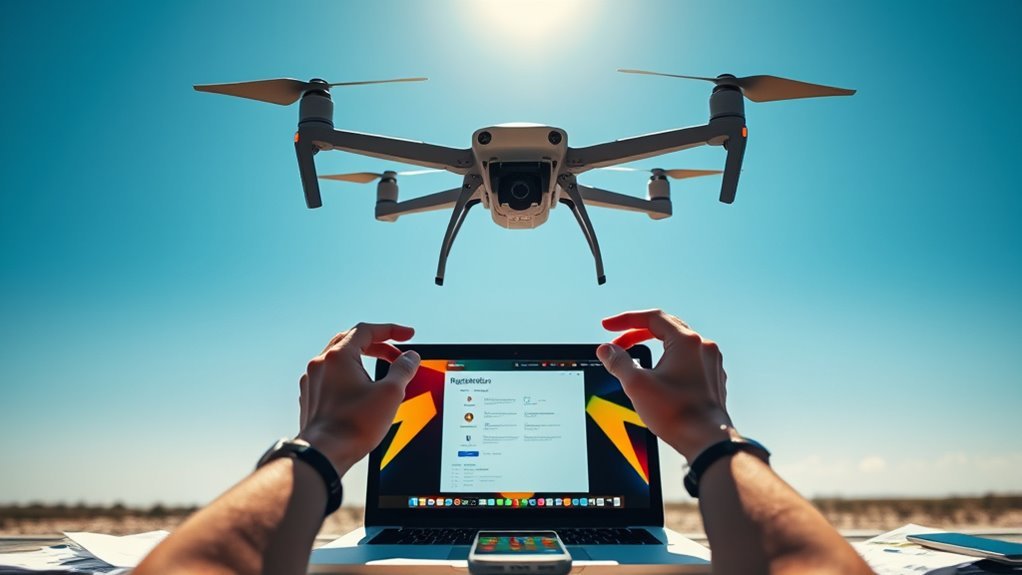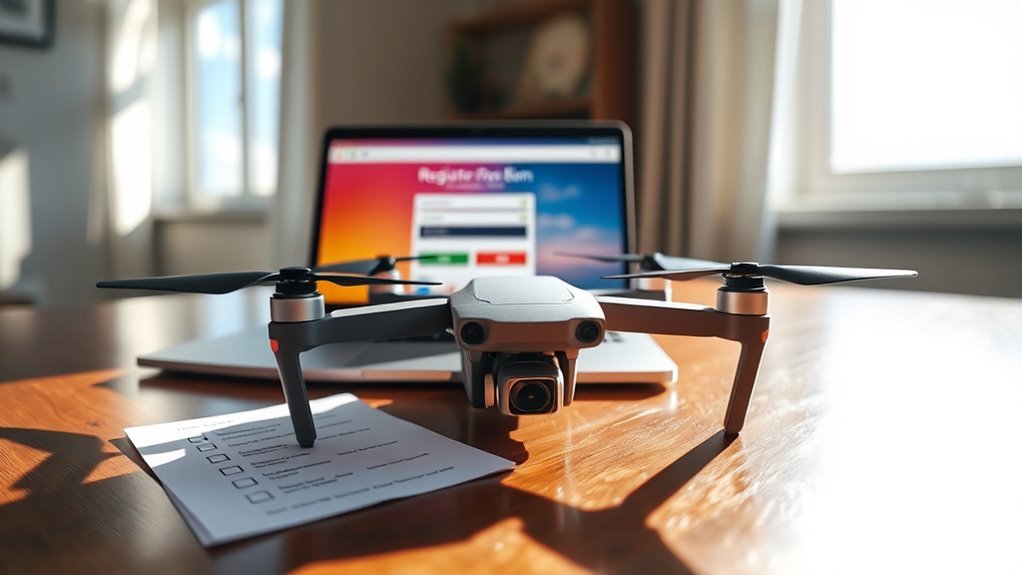To register your drone, start by understanding the FAA’s requirements to guarantee compliance. Next, gather necessary information like your drone’s make, model, and weight. Choose the right registration platform, then complete the online form accurately. Pay the $5 registration fee, and you’ll receive a unique registration number. Finally, mark your drone permanently with this number for visibility. Following these steps promotes responsible flying. Stay with us to explore more details on safe drone operation.
Understand the Registration Requirements

Before you begin the registration process for your drone, it’s vital to understand the specific requirements set forth by the Federal Aviation Administration (FAA). The FAA mandates that all drones weighing over 0.55 pounds must be registered. This process involves providing your name, address, and email, along with a registration fee. Understanding these drone regulations not only guarantees compliance but also enhances your flying experience. Registration benefits include legal protection and improved accountability, allowing you to operate your drone freely without facing legal repercussions. Additionally, registered drones are easier to recover if lost, granting you peace of mind. Familiarizing yourself with these requirements is essential for enjoying the freedom of flying your drone responsibly.
Gather Necessary Information

Gathering the necessary information is essential for a smooth drone registration process. First, you’ll need to compile your drone specifications, including the make, model, and weight of your device. Accurate details guarantee compliance with regulatory standards and help avoid issues later on. Next, gather your ownership documentation, which may include purchase receipts or proof of ownership. This paperwork verifies that you’re the legitimate owner and can be critical if any disputes arise. Having this information ready not only streamlines your registration but also empowers you as a responsible drone operator. By confirming you’ve got everything lined up before you start, you can enjoy the freedom of flying your drone without unnecessary delays.
Choose the Right Registration Platform

With your drone specifications and ownership documentation in hand, the next step is to select the appropriate registration platform. There are several registration platforms available that cater to drone owners, offering various online services. When choosing, verify the platform complies with FAA regulations to avoid any potential legal issues. Look for user-friendly interfaces that simplify the registration process while providing secure data handling. Some platforms may also offer additional features, like tracking your registration status or reminders for renewals. Evaluate each option carefully, balancing convenience with compliance to maintain your freedom as a drone operator. By selecting the right registration platform, you’re taking an essential step towards responsible and legal drone usage.
Complete the Registration Form
Completing the registration form is a critical step in ensuring your drone is legally recognized. To begin, gather necessary information such as your drone’s make, model, and serial number. Use online registration form examples as templates to guide your completion process. When filling out the form, double-check that all details are accurate and consistent with your drone’s specifications. This precision minimizes the risk of delays or rejections. Form completion tips include using clear, legible handwriting if submitting by mail, and ensuring your contact information is up-to-date. Remember, this registration not only affirms your rights but also promotes safe and responsible drone use in shared airspace. Take this step seriously to secure your freedom in flying your drone.
Pay the Registration Fee
Now that you’ve completed the registration form, it’s time to pay the registration fee. You can typically choose from various payment methods, including credit cards and electronic transfers. The fee amount varies based on your drone’s weight category, so make certain you’re aware of the specifics before proceeding.
Payment Methods Available
When you’re ready to pay the registration fee for your drone, there are several payment methods available to facilitate the process. You can choose from various credit card options, making sure that you can use a card that suits your preferences. Online payment is the most convenient method, allowing you to complete your registration from the comfort of your home. Simply select your preferred payment option during the registration process, enter your payment details, and verify your transaction. It’s important to make certain your payment information is secure, as regulatory compliance mandates that your data remains protected. Once your payment is successful, you’ll receive confirmation, allowing you to pursue your passion for flying drones with the freedom you desire.
Fee Amount Details
The registration fee for your drone is a flat rate of $5, which is required for every drone you intend to operate. Understanding the fee structure is essential for compliance and maintaining your freedom to fly. Here’s a quick breakdown:
| Fee Type | Amount | Notes |
|---|---|---|
| Registration Fee | $5 | Per drone |
| Renewal Fee | $5 | Every three years |
| Late Registration | $5 | Additional penalty |
| New User Fee | $0 | First-time registrants |
Ensure you pay this registration fee promptly to avoid any issues. Following these guidelines helps you stay within regulatory boundaries while enjoying the freedom of flying your drone without interruptions.
Receive Your Registration Number
Once you’ve paid the registration fee, you’ll receive your unique registration number, which is essential for compliance with FAA regulations. You can retrieve it through the online portal where you completed your registration. This number must be displayed on your drone to guarantee legal operation.
Importance of Registration Number
Registering your drone isn’t just a regulatory requirement; it’s vital for ensuring accountability and safety in the airspace. Your registration number serves as a unique identifier, linking you to your drone and providing a clear record of ownership. This is important in mitigating the legal implications of unauthorized flights or accidents. In the event of an incident, having a registration number can simplify investigations and assist authorities in addressing safety concerns. Additionally, it enhances the safety benefits of drone operation by promoting responsible flying practices. By registering, you’re not only complying with regulations but also contributing to a safer environment for everyone. Embrace your freedom to fly responsibly—your registration number is a key part of that commitment.
How to Retrieve It
After completing your drone registration online, you’ll need to retrieve your registration number, which is typically sent to you via email. Check your inbox for a confirmation email from the relevant regulatory body; this email contains your unique registration number vital for drone identification. If you don’t see it in your inbox, look in your spam or junk folder, as sometimes important emails get filtered incorrectly. If you still can’t find it, visit the registration website and use the registration retrieval feature, entering the required information such as your name and email address. This guarantees you receive your number promptly, allowing you to fly freely while complying with regulations. Always keep this number accessible for future reference.
Using Your Registration Number
Using your registration number correctly is vital for compliance with drone regulations. The significance of this number lies in its role in identifying your drone and ensuring accountability. Here are some essential usage guidelines:
| Usage | Details |
|---|---|
| Displaying | Affix your registration number visibly on your drone. |
| Documentation | Include it on any flight logs or reports. |
| Reporting | Use it when communicating with authorities about your drone. |
Mark Your Drone With the Registration Number
To comply with FAA regulations, it is imperative to mark your drone with the registration number assigned to it. This guarantees drone visibility and helps authorities identify your aircraft, enhancing accountability. You can use various labeling techniques, such as decals or engraving, to permanently display the registration number. Ascertain the number is legible and located in a conspicuous place, preferably on the exterior of the drone. The size of the text should meet the FAA’s requirements, typically at least 0.3 inches tall. By following these guidelines, you not only adhere to legal mandates but also maintain the freedom to fly your drone responsibly. Don’t overlook this important step; it’s essential for your flying experience.
Frequently Asked Questions
How Long Does the Registration Process Take?
The registration duration varies, but you can typically expect processing times between a few minutes to several days. It’s crucial to verify all required information is accurate to avoid delays in receiving your registration confirmation.
Can I Register Multiple Drones at Once?
When it comes to multiple drone registration, you’ve hit the nail on the head! You can register several drones simultaneously, streamlining the registration process. Just follow these registration process tips for a smooth experience.
What if I Lose My Registration Number?
If you lose your registration number, you can retrieve your information through the FAA’s online portal. Consider replacing registration if necessary, ensuring you maintain compliance while enjoying the freedom your drone offers.
Is Drone Registration Mandatory for Recreational Use?
You might think flying a drone is as free as a bird, but under drone regulations overview, registration’s mandatory for recreational use. Familiarize yourself with recreational drone guidelines to enjoy your flights without hassle.
What Are the Consequences of Not Registering My Drone?
Not registering your drone can lead to legal implications, including fines and enforcement actions from authorities. You risk losing your flying privileges and facing penalties that undermine your freedom to operate unmanned aircraft safely and responsibly.

